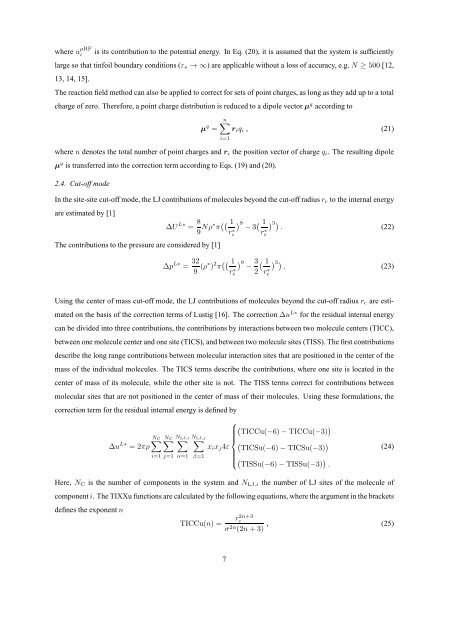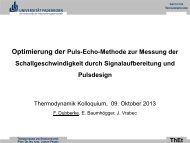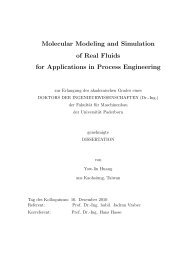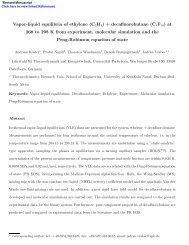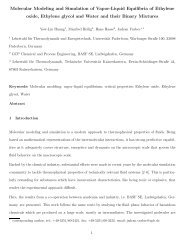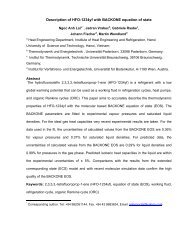ms2: A Molecular Simulation Tool for Thermodynamic Properties
ms2: A Molecular Simulation Tool for Thermodynamic Properties
ms2: A Molecular Simulation Tool for Thermodynamic Properties
You also want an ePaper? Increase the reach of your titles
YUMPU automatically turns print PDFs into web optimized ePapers that Google loves.
where u µRF<br />
i is its contribution to the potential energy. In Eq. (20), it is assumed that the system is sufficiently<br />
large so that tinfoil boundary conditions (εs → ∞) are applicable without a loss of accuracy, e.g.N ≥ 500 [12,<br />
13, 14, 15].<br />
The reaction field method can also be applied to correct <strong>for</strong> sets of point charges, as long as they add up to a total<br />
charge of zero. There<strong>for</strong>e, a point charge distribution is reduced to a dipole vectorµ q according to<br />
µ q =<br />
n<br />
riqi , (21)<br />
i=1<br />
where n denotes the total number of point charges and ri the position vector of charge qi. The resulting dipole<br />
µ q is transferred into the correction term according to Eqs. (19) and (20).<br />
2.4. Cut-off mode<br />
In the site-site cut-off mode, the LJ contributions of molecules beyond the cut-off radiusrc to the internal energy<br />
are estimated by [1]<br />
The contributions to the pressure are considered by [1]<br />
∆U L∗ = 8<br />
9 Nρ∗π 1<br />
r∗ 9 1<br />
−3<br />
c r∗ 3 . (22)<br />
c<br />
∆p L∗ = 32<br />
9 (ρ∗ ) 2 π 1<br />
r ∗ c<br />
9 3<br />
1<br />
−<br />
2 r∗ 3 . (23)<br />
c<br />
Using the center of mass cut-off mode, the LJ contributions of molecules beyond the cut-off radius rc are esti-<br />
mated on the basis of the correction terms of Lustig [16]. The correction ∆u L∗ <strong>for</strong> the residual internal energy<br />
can be divided into three contributions, the contributions by interactions between two molecule centers (TICC),<br />
between one molecule center and one site (TICS), and between two molecule sites (TISS). The first contributions<br />
describe the long range contributions between molecular interaction sites that are positioned in the center of the<br />
mass of the individual molecules. The TICS terms describe the contributions, where one site is located in the<br />
center of mass of its molecule, while the other site is not. The TISS terms correct <strong>for</strong> contributions between<br />
molecular sites that are not positioned in the center of mass of their molecules. Using these <strong>for</strong>mulations, the<br />
correction term <strong>for</strong> the residual internal energy is defined by<br />
∆u L∗ ⎧<br />
<br />
TICCu(−6)−TICCu(−3)<br />
NC NC NLJ,i NLJ,j <br />
<br />
⎪⎨<br />
<br />
= 2πρ xixj4ε TICSu(−6)−TICSu(−3)<br />
i=1 j=1 α=1 β=1 ⎪⎩ <br />
TISSu(−6)−TISSu(−3) .<br />
Here, NC is the number of components in the system and NLJ,i the number of LJ sites of the molecule of<br />
componenti. The TIXXu functions are calculated by the following equations, where the argument in the brackets<br />
defines the exponentn<br />
TICCu(n) =<br />
(24)<br />
r2n+3 c<br />
σ2n , (25)<br />
(2n+3)<br />
7


